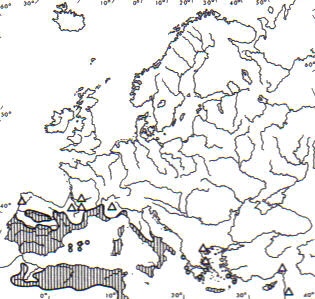|
|
FILMED Phylogeography of representative plant species of the Mediterranean flora
Rosmarinus officinalis L. Rosemary
|
|
|
Links
|
Left.: Common blue-flowered plants in Catarroja, (Valencia, Spain), 01.2006; Right: A specimen from a pink-flowered population in El Viso (Cůrdoba, Spain), 04.2007 © E. Laguna
Description: A dwarf to tall evergreen, dense, aromatic shrub up to 1,5-2 m. Leaves in dense opposite clusters. Narrow or linear leaves up to 4 cm long, with downturned margins, dark green in the upper surface and often withe or grey in the lower one. Withe, blue or lilac -rarely pink- 2-lipped flowers, up to 20 mm long, sometime spotted, showing prominent, projecting stamens and style. The ripped fruit is compund by 4 dark-brown nutlets enclosed by the billabiated calyx. It deals with one of the most traditional Mediterranean culinary herbs. Diploid, 2n=24, n=12.
Distribution: Western and Central Mediterranean-climate area, lacking progressively towards the East.
Distribution map of Rosmarinus officinalis* *From BOL“S, O. & J. VIGO (1984-2001), reproduced with the editor's permission.
Habitat: Shrublands, being more abundant on the open 'matorral' on limestones, in dry or semi-arid zones, up to 1.500-1.800 m.
Differences in shape and height in R. officinalis. Left.: Erect, common specimens of var. opfficinalis , Real de Montroi (Valencia, Spain) 03.2006, E. Laguna; Right: Plants apparently belonging to var. prostratus, Oued Laou, Akchoud (Marocco), 11.2007, © F. Boisset
Variability: Very variable in size and aspect of the whole plant. Most populations are compound by erect plants, but also prostrate forms can be dominant in some grounds, particularly on inslands, coastal or aride sites; some of them were described in the past as Rosmarinus prostratus Fl. Corc. -maybe partially equivalent to R. officinalis var. prostratus Hort.-, and they are currently under taxonomic investigation in the framework of the project FILMED; the prostrate plants from Balearic Islands have been described as var. palaui O. BolÚs & Molin. (= R. officinalis subsp. palaui (O. BolÚs & Molin.) Romo = R. palaui (O. BolÚs & Molin.) Rivas-Mart. & M.J. Costa). Erect shrubs with pale-lillac to yellow flowers from the Western Tellian Atlas (Northern Africa) were designated as var. pallescens (=R. pallescens (Maire) Sennen); pale-pink flowers are also usual in some parts of Western Spain, on siliceous soils. The distribution area of R. officinalis var. officinalis overlaps with their relatives R. tomentosus Hub.-Mor. & Maire in SE Spain, and R. eriocalyx Jord. & Fourr., (incl. R. tournefortii (Murb.) Jahandiez & Maire), both in SE Spain and NW Africa. Thriugh the overlapping area the hybrids Rosmarinus x noeanus Maire ex J.L. Rosķa (R. eriocalyx x officinalis) and R. x mendizabalii (R. officinalis x tomentosus) can be found.
Variability in Spanish, prostrate forms of R. officinalis: Left: var. palaui, Fornells, Minorca (Balearic Islands); Right: specimens apparently belonging to var. prostratus, Paterna (Valencia), Both by 02.2006, © E. Laguna
FILMED's selected populations: Argelia (4), France (4), Greece (1), Italy (5), Lybia (2), Marocco (4**), Portugal (2), Spain (31*), Tunisia (2), Turkey (1) In addition 1 population of Rosmarinus eriocalyx has been sampled from Marocco. *5 populations are prostrate plants belonging to var. palaui (3 samples from Balearic Islands) and var. prostratus s.l. (2 samples from Valencia). **2 populations are prostrate froms belonging to var. prostratus s.l.
References: -BOL“S, O. & J. VIGO (1984-2001). Flora dels PaÔsos Catalans. 4 vols. Ed. Barcino. Barcelona. -BURNIE, D. 1995. Wild flowers of the Mediterranean. 320 pp. Dorling Kindersley. London. -DAVIES, P. & B. GIBBONS. 1993. Field guide to the Wild Flowers of Southern Europe. 320 pp. Crowood Press. Marlborough. -POLUNIN, O. & A. HUXLEY. 1990. Flowers of the Mediterranean. 2nd ed. 272 pp. Chatto & Windus. London. POLUNIN, O. & B.E. SMITHIES. 1997. Flowers of South-West Europe. 480 pp. Oxford University Press. Oxford. -SCH÷NFELDER, I. & 9. SCH÷NFELDER. 1984. Collins photoguide to the wildflowers of the Mediterranean. Collins. London. -TUTIN, T.G., V.H. HEYWOOD, N.A. BURGES, D.H. VALENTINE, S.M. WALTERS & D.A. WEBB. 1964-1980. Flora Europaea. 5 vols. Cambridge University Press. Cambridge. -VEDEL, H. 1978. Trees and shrubs of the Mediterranean. Penguin. London.
Ungrazed population of prostrate Rosmarinus officinalis near Paterna (Valencia, Spain), 01.2006, © E. Laguna
Recommended webpages: -Virtual Herbarium of the Western Mediterranean: http://herbarivirtual.uib.es/cas-med/index.html -Flora Iberica: http://www.rjb.csic.es/floraiberica/index.php -Anthos: http://www.anthos.es -Mediterranean Wildflowers (pictures): http://www.florasilvestre.es/mediterranea/index.htm -Spanish Wildflowers (pictures): http://www.hoseito.com/FLORES%20SILVESTRES/index.htm
-Wikipedia: http://en.wikipedia.org/wiki/Rosmarinus_officinalis
|
|
|
Optimized for 1280 x 1024 dpi screen. ©FILMED CGL2006-09427BOS project 2007 University of Valencia & CIEF |
